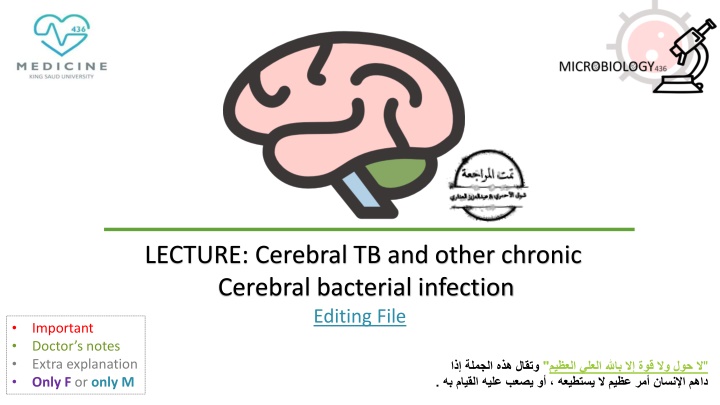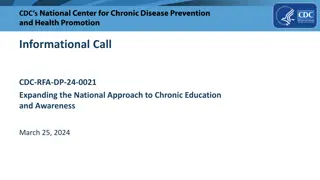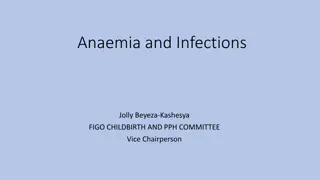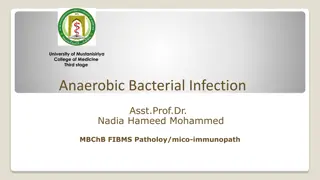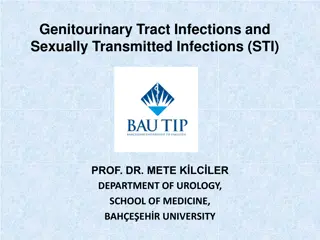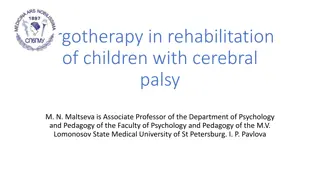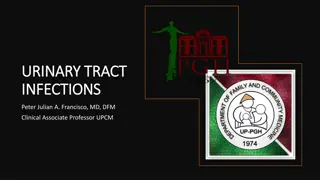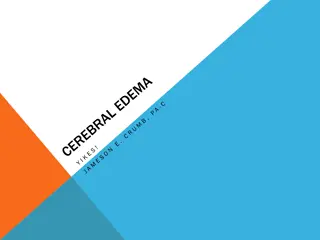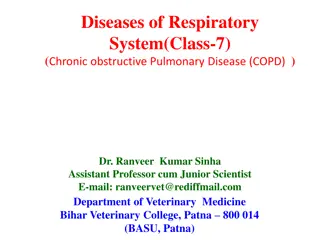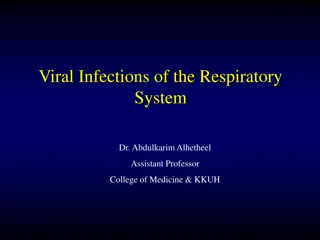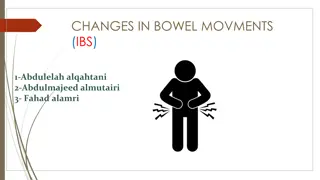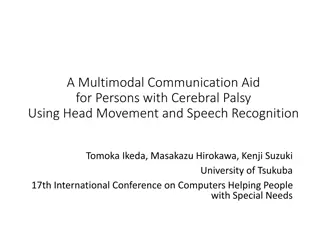Chronic Cerebral and Meningitic Infections: Etiology, Symptoms, and Microbiological Causes
Symptoms and signs, microbiological causes, and clinical differentiation of chronic cerebral and meningitic infections are discussed in this lecture. Learn about identification, diagnostic approaches, and treatment, focusing on bacterial infections like Tuberculosis and Brucellosis, as well as other pathogens including fungi, parasites, and viruses.
Download Presentation

Please find below an Image/Link to download the presentation.
The content on the website is provided AS IS for your information and personal use only. It may not be sold, licensed, or shared on other websites without obtaining consent from the author.If you encounter any issues during the download, it is possible that the publisher has removed the file from their server.
You are allowed to download the files provided on this website for personal or commercial use, subject to the condition that they are used lawfully. All files are the property of their respective owners.
The content on the website is provided AS IS for your information and personal use only. It may not be sold, licensed, or shared on other websites without obtaining consent from the author.
E N D
Presentation Transcript
LECTURE: Cerebral TB and other chronic Cerebral bacterial infection Editing File Important Doctor s notes Extra explanation Only F or only M " " .
OBJECTIVES: Upon completion of the lecture , students should be able to: Etiology Identification Clinical presentation Diagnostic approaches Treatment Of chronic cerebral and meningitic infections.
Symptoms and signs of chronic cerebral and Symptoms and signs of chronic cerebral and meningetic can be can be recurrent recurrent meningetic infection: over infection: over long period long period or or SYMPTOM: SIGN: Chronic headache +/-Papilloedema (TB infects base of the skull so it causes papilloedema) Neck or back pain Brudzinski or Kerning 'positive sign of meningeal irritation Change in personality Altered mental status, memory loss, etc Facial weakness Seventh nerve palsy Double vision ,visual loss 3,4,6 th,Nerve palsy Arm and leg weakness Ataxia clumsiness Hydrocephalus They are similar to symptoms of a brain tumor.
Microbiological Causes Of Chronic Cerebral Infection And Meningitis: Microbiological Causes Of Chronic Cerebral Infection And Meningitis: Bacteria: (most sever) Most Important. Common in saudi : Brucella-Brucellosis , TB-Tuberculosis Partially treated acute meningitis: Neisseria Meningitidis , Streptococcus Pneumoniae , Haemophilus influenzae. Others: Syphilis by Treponema Pallidum, Leptospirosis by L. Ictero haemorrhagica, Lyme Disease by Borrelia burgdorferi - Lyme Disease (not common in Saudi Arabia), Nocardiosis by Nocardia Asteroids e.g. N. Asteroids, Cerebral abscess can also same preferred as chronic infection. Fungal: Cryptococcus neoformans ( Aids patients), Candida species (in Saudi Arabia species mainly Candida albicans in immunocompromised patients) , Aspergillus species ( cancer patients + very common) , Histoplasma capsulatum. fungal infection doesn t come to normal person, usually has underlying disease. Parasitic: Toxoplasma gonodii (most common , from kittens ) , Trypanosoiasis (caused by Trypanosoma brucei gambiense , Trypanosoma brucei rhodesiense , Trypanosoma cruzi Acanthamoeba spp (Rare causes). Virus: (less sever) Some virus can some present as chronic meningitis these include: Mumps , Herpes simplex , HIV. Nocardia is a pyogen which causes brain abscess Syphilis used to be uncommon, but when HIV arised, with it came back syphilis.
The most important causes of chronic bacterial cerebral and The most important causes of chronic bacterial cerebral and menigetic Arabia are : Arabia are : menigetic infection in Saudi infection in Saudi Tuberculosis Brucellosis Clinical History They should differentiated on the basis of: Clinical signs in other organism Occupations Cerebrospinal fluid findings Clinical symptoms
Brucellosis: Brucellosis: Etiology Brucella Species | Gram -ve Coccobacilli | Brucella Melitensis is the most common in Saudi Arabia Transmission Contact with domestic animals or consumption of raw milk and dairy products ( camels ) It usually presents with Pyrexia (fever) of unknown organism of intermittent nature. The fever is accompanied by night sweating, however, in between the attacks of fever the patient is not very ill. Because the symptoms are not specific and flu-like, untreated Brucilla can invade the CNS, causing chronic cerebral infection and meningitis. Presentation Laboratory CSF culture and Serology. Two of the following 3 drugs Tetracycline Rifampicin Cotrimoxazole Rifampicin and Cotrimoxazole are preferred as they have good penetration power in the BBB. Treatment
Tuberculosis Tuberculosis Etiology: Mycobacterium Species (Resist Staining) Mycobacterium tuberculosis which infected 1\3 the human race The patient usually presents with fever of long duration You will never have TB without fever. Symptoms of cough, and coughing blood (Haemoptysis) when the chest is affected. It can present as meningitis or cerebral infection with chronic neurological symptoms and signs. Parenchymal CNS involvement can occur in the form of tuberculoma or, more rarely, abscess. Spinal meningitis,radiculomyelitis, spondylitis, or spinal cord infraction pott s spine and pott s paraplegia Presentation: Classification Intracranial spinal Tuberculous meningitis (TBM). TBM with Miliary Tuberculosis. Tuberculous Encephalopathy and Vasculopathy. Single or multiple space-occupying lesions (Tuberculoma). Tuberculoma with Miliary Tuberculosis. Tuberculous abscess Pott sspine. Pott sparaplegia. TuberculousArachnoiditis (myeloradiculopathy). Non-osseousspinaltuberculoma. Spinal meningitis.
Chronic cerebral and meningeal infection can produce: Chronic cerebral and meningeal infection can produce:- - Neurological disability and, may be Fatal if not treated They usually have Slow insidious onset with progression of signs and symptoms over a period of weeks* They differ from those of acute infection which have Rapid on set of symptoms and signs They are usually diagnosed ,if the neurological syndrome exists for > 4 weeks *which is a good thing because it gives more time to diagnose
Diagnosis of chronic cerebral and meningeal infections Diagnosis of chronic cerebral and meningeal infections History for Brucellosis and Tuberculosis Clinical examination Imaging by x- ray or MRI or ultrasound Laboratory findings As in acute pyogenic infections, in chronic cerebral and meningeal infections the following As in acute pyogenic infections, in chronic cerebral and meningeal infections the following CSF finding will be as follows: CSF finding will be as follows: CSF Findings Increased CSF pressure indicating increased intra cranial pressure. Increased protein level due to presence of inflammatory substance, dead organism, protein and WBC. Reduced glucose level ( Normally it is 2/3 of serum glucose level). Increased local white cell count but in chronic infection the differential shows lymphocytosis while in acute infections there is increased % of polymorphonuclear leukocytes. Gram stain can sometimes show the causative organism. Z-N Stain (Ziehl-Neelsen stain) can show AFB (acid-fast bacilli) of T.B while modified Z-N can show Nocardia
Diagnosis Clinical CSF Imaging Fever and headache for >14 days. Vomiting. Altered sensorium or focal neurological deficit. Mantoux test (Tuberculin skin test) occupying lesions (Tuberculoma). Tuberculoma with Miliary Tuberculosis. Tuberculous abscess Microscopy: Z.N. Stain. Culture: on L.J. or Fluid Medium. PCR. Pleocytosis : >20 cells, >60% lymphocytes. Increased proteins : >100 mg/dl. Low sugar: <60%. Malignant cells: should be -ve. (because tb formation a granuloma which a mass so it be confuse with tumor) Exudates in basal cisterns or in sylvian fissure hydrocephalus. Infarcts (basal ganglionic). Gyral enhancement. If it is meningitis, we would find vascular enhancement Tuberculoma formation. Treatment: For the first 2 months: Rifampicin + Isoniazid (INH) + Ethambutol + Pyrazinamide Then, for 4-6 months: Rifampicin + Isoniazid (INH)
Extra intense enhancement of the basal subarachnoid cisterns in acute/subacute TB meningitis
Case report: disseminated tuberculosis Case report: disseminated tuberculosis A 30-year-old woman presented with headache, vomiting and fever (104 F), and feeling disoriented and inattentive for 6 days duration. She was conscious, had lateral rectus palsy along with bilateral papilledema1. Left plantar was extended. Neck rigidity and Kernig s sign were present. Other systemic and general examinations were normal. All hematological and serum biochemical parameters, including liver function tests, were normal. Chest X-ray showed miliary2 shadows in both lungs (figure1). CSF revealed elevated opening pressure, proteins 248 mg/dl, sugar 34 mg/dl (corresponding blood sugar was 98 mg/dl); 204 cells/ml, 15% polymorph, the rest was lymphocytes (85%). CT of the head showed multiple small enhancing lesions in brain parenchyma (figure2). The patient was given antituberculous treatment and corticosteroids3. She showed significant improvement in all her symptoms after 15 days. 1 2 1This means that there is increased intracranial pressure. Possible diagnosis of Acute Pyogenic Meningitis. 2Miliary indicates a hematogenous spread, you will notice small spots in the lungs. 3When you give steroids to a patient and he/she gets better, this proves the involvement of the immune system as a cause of disease. TB uses the immune system to cause a disease, so to obtain a better result in treatment the anti TB is given with the steroids.
EXTRA A lumbar myelogram showing spinal block at the level of T9 vertebra, a paraspinal abscess producing spinal block, paraspinal abscess compressing the spinal cord. A sign indicating the presence of meningitis (inflammation of the meninges covering the brain and spinal cord). The test for Kernig sign is done by having the person lie flat on the back, flex the thigh so that it is at a right angle to the trunk, and completely extend the leg at the knee joint. CT demonstrating Tuberculoma
Laboratory Findings: Laboratory Findings: This is mainly related to the laboratory examination of cerebrospinal fluid including:- a) Collect of 2-5 ml of CSF and checking for the pressure b) Biochemical investigation for : 1. Total protein 2. Glucose level in comparison to the serum glucose level a) Microscopy: 1. Presence of organism 2. Total white cell count 3. Differential count mainly for:- a) Polymorphic b) Lymphocytes
Laboratory diagnosis of cerebral and Laboratory diagnosis of cerebral and meningetic meningetic Tuberculosis and Brucellosis Tuberculosis and Brucellosis VDRL and other serological causes for syphilis Mantoux test, Tuberculin skin test(TST) Chest x-ray for primary focus Combination of these finding with clinical history and examination finding : CSF microscopy for AFB Culture for CSF for Brucella,T.B Mycobacterium tuberculosis, Leplospira other Bacteria Wet preparation of CSF for fungal and parasite CSF culture an solid medium L.J or fluid medium. PCR or other molecular biopsy test for presence of bacterial element (it is fast but sometimes gives false negative) Culture of CSF for Brucella India ink for Cryptococcus neoforman Serology for Brucella
SUMMARY: TB and Brucellosis are the most common cause for chronic cerebral infections. Brain is involved so sensory and motor symptoms will appear . Its important to take a good clinical history to differentiate between TB and Brucellosis. Brucellosis is gram (-) bacteria coccobacilli , transmission from Contact with domestic animals or consumption of raw milk and dairy products ( camels and gouts ). Treatment of brucellosis is combination of two antibiotics usually Rifampicin and Cotrimoxazole . TB Mycobacterium Species (Resist Staining) so we use Z-N stain . TB patient usually presents with fever of long duration. CSF findings shows high protein , low glucose , high CSF pressure , lymphocytosis .
QUIZ: 1. the commonest parasitic cause of chronic cerebral infarction an meningitis is: a) Gambines b) acanthamoeba c) toxoplasma gonodii d) borlaexaust 4.which one of the following is a major risk factor of T.B in Saudi Arabia: a) AIDS b) diabetes mellitus c) U.R.T.I d) myocardial infarction 5.which one of the following should be excluded before diagnosing a patient with T.B a) Pneumonia b) Angina pectoris c) Brucellosis d) L.R.T.I 2. between the attacks of fever the patient isn t very ill, it indicate which one of the following micro organism: a) T.B b) Pneumonia c) Candida d) Brucellosis 6. the commonest bacterial cause of chronic cerebral infarction and meningitis is: a) T.B + brucellosis b) brucellosis + S.Pneumonia c) T.B + E. Coli d) pseudomonas aeruginosa 3. Which of the following drugs is contraindicated when treating a child with brucellosis: a) Refanpicin b) Cotrimoxazole c) Tetracyclin d) pyrazinamide Answers : 1-C 2-D 3-C 4-B 5-C 6-A
Case: Khalid , a 35 -year-old male went to see a neurologist in KKHU because of chronic headache. He reported that he has been suffering from unresolved severe headache with fever and night sweats , between fever he doesn't t feel sick. he told the doctor that he loves drinking camel milk. Q1) What is your diagnose ? Ans) Brucellosis Q2) regarding your diagnose , what is the proper treatment ? Ans) Rifampicin and Cotrimoxazole .
THANK YOU FOR CHECKING OUR WORK, BEST OF LUCK! Hamad Alkhudhairy Talal alhuqayl Nawaf alkhudhairy Saud alshenaifi Abdulmalik alghanam Meshal aleiadi Ibrahim fetyani Shrooq Alsomali Ohoud Abdullah Rana Barasain Doctors slides
